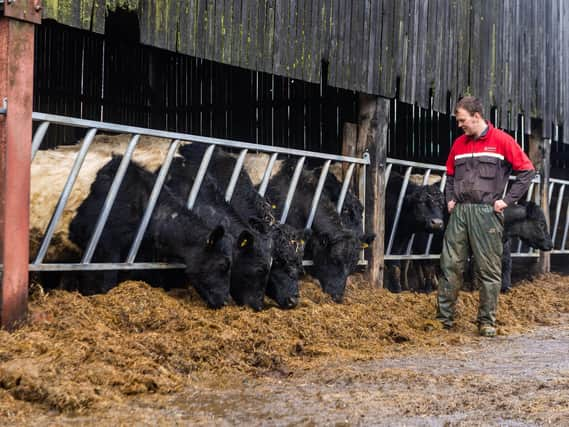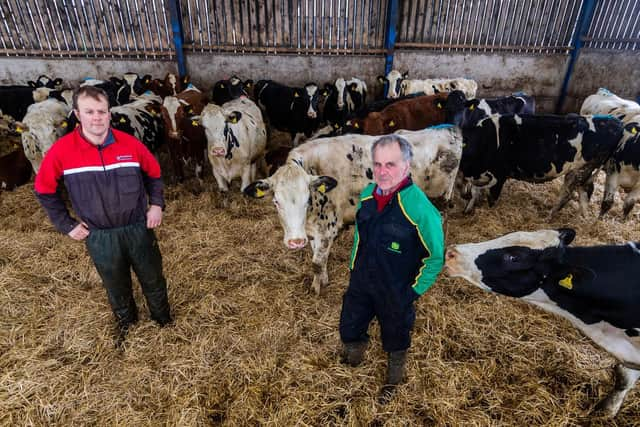Farm of the Week: The North York Moors dairy cattle breeders who haven't bought new stock since 1980


A family partnership sees Chris Foster running Shortwaite Farm in Lealholm, having taken over he reins from his father Colin and mum Audrey.
It was Chris’s great-grandfather who brought the Foster family to Shortwaite from Ugthorpe in 1927.
Advertisement
Hide AdAdvertisement
Hide Ad“My grandad Ralph and his brother Bernard farmed together for some years and then Dad took on the farm as a teenager in partnership with his brother Alan who ran a sheep, beef and arable operation at Coquet Nook Farm also on the Mulgrave Estate.”


Now the Shortwaite herd consists of 220 pedigree Holstein cows across 550 acres of which the largest proportion is tenanted from Lord Normanby’s Mulgrave Estate.
Chris said it was a decision by his father in the 1980s that put them on the path to Holsteins.
“Shortwaite has always been home to a Foster dairy herd. Originally, like most farms in the area, our cows would be Northern Dairy Shorthorns. It was Dad who pushed it on from 16 Friesians to 100 Holsteins.
Advertisement
Hide AdAdvertisement
Hide Ad“We haven’t purchased a single animal since 1980. Increasing the size of the herd has been through careful management, breeding our own replacements through using AI, which Dad still handles.
“During the 80s he also made the decision to move the herd away from Friesian to Holstein.”
Cow numbers have doubled since 2010, when Chris returned to Lealholm following his agricultural degree studies in Edinburgh and seven years working with a dairy farming consultancy in Cheshire.
“Buying 135 acres on a neighbouring farm just across the beck with good cropping land gave us the opportunity to expand the herd and grow good quality winter wheat across 75 acres of easy working sandy loam soil,” Chris said.
Advertisement
Hide AdAdvertisement
Hide Ad“We are growing the variety Extase this year and we sell half of the grain with the other half going into feed rations.”
“Between 2010 to 2014 we took the herd up to 160 cows and then in 2014, we invested in a brand-new Pearson 20 x 40 swingover milking parlour, which meant we could increase the herd to 220 dairy cows by 2016 and have the capacity to go to 300.”
Chris said he had seen some dairy farmers experience several months of changeover when a new milking parlour was being put in place so he went for an ‘express fit’ service which meant they were ready to go in ten days.
Along with the milking parlour, the farm also made other big investments including a new bulk milk tank, slurry system, cow cubicles and cow sheds.
Advertisement
Hide AdAdvertisement
Hide Ad“Our bank manager did raise an eyebrow or two,” said Chris.
“We also added the tenancy of nearby 160-acre Westonby Farm in 2016, which again gives us scope for the future.”
The herd average is around 11,000 litres per lactation with the cows managing around five lactations, Chris said, with milk sold to farmer-owned dairy cooperative First Milk, which the farm has recently bought share capital in.
“We had previously been with another dairy company which went into administration and we are very happy where we are now as part of a farmer-owned group.”
Advertisement
Hide AdAdvertisement
Hide AdThe Fosters also provide quality beef stock with block calving starting from September 1 and running until Christmas, with a target of 140 calvings in the first month from the cows that have all been put to Holstein AI.
The herd grazes in the Lealholm pastures from the end of April or early May until it is calving time.
“It’s from those that calve in September we produce our heifer replacements,” said Chris.
“We don’t use sexed semen, which means we would anticipate around half to be heifers and the others bull calves. We have a really good relationship with a farmer who buys all of the bull calves born during September, when they are three weeks old.”
Advertisement
Hide AdAdvertisement
Hide AdThe remainder of the dairy herd is put to Belgian Blue AI that sees the calves produced from October onwards providing stock for specialist markets.
“We keep all of the bullocks and sell them at 12 months as stores at Ruswarp Mart,” said Chris.
“Our heifers - as they come from great dairy lines - are renowned for their quantity and quality of milk produced. We sell them as suckler cow replacements for Limousin breeders in Cumbria and Yorkshire as they are fantastic embryo recipients and good mothers.”
Chris said he tries to keep one step ahead of the game wherever he can and producing a polled herd of pedigree Holsteins has been another strand to his future plans.
Advertisement
Hide AdAdvertisement
Hide Ad“I can foresee a time when dehorning cattle could be something that might not be allowed. My feeling is if we were already completely polled when that time comes it might give us a bit of an edge. That’s why we began importing polled semen from Mastergen in 2010.”
Four years ago Chris diversified into a herd of Belted Galloway cattle, when the Mulgrave Estate planned to put several acres of moorland into conservation grazing with Natural England.
“The estate had 60 acres of moorland adjacent to us that they were looking to put into conservation grazing and I was concerned about the biosecurity risk to our herd and approached the estate. I asked whether, rather than bring anyone else’s stock in, they would let me stock it.”
Three years on, Chris is grazing a herd of 20 cattle he has grown through semen importation selection on the acreage all year round.
“We served around ten to 12 of our cows the first year and we will continue to add to our number when necessary.
“When the time comes we will either sell them as big store cattle or as fatstock.”